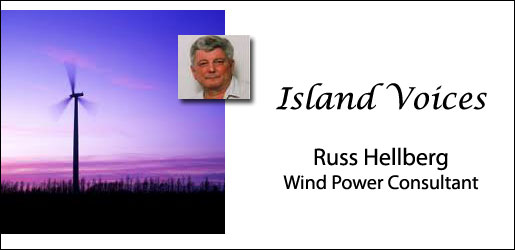Current Article ∙ Archive ∙ Back to Island Voices
Birds, Bats and Wind Farms
One area of concern to many people that are not familiar with wind power is birds and bats are affected by wind farms. The following is a brief summary prepared by the Canadian Wind energy Association (CanWea).
Birds, bats and wind energy.
Studies show that modern wind farms with sensitive siting have no significant adverse effect on bird populations. The wind energy industry is investing in closely monitoring this important issue and continues to work vigilantly to avoid any significant impact. Wind energy is emission-free and can help offset the effects of climate change. Wind farms can also be developed with respect for habitats addressing two significant threats to birds and all other forms of wildlife.
How birds and wind turbines interrelate.
There are a few ways that wind turbines might interfere with birds, one is the potential impact to their natural habitat, another is through possible collisions with the turbines themselves. A well-sited wind farm goes a long way towards minimizing the risk to birds and brings about a natural and healthy co-existence between wind energy and avian creatures of all stripes.
A study reviewing the impact of wind farms on birds in the US, found that generally, only 2 birds per turbine per year ever die in collisions with wind turbines. Bear in mind that this is far less than the millions of deaths per year associated with birds crashing into buildings and windows, and the many millions of deaths associated with birds colliding with vehicles. A real concern for birds is noted in the 2004 study in Nature that estimated that up to a quarter of all bird species could become extinct by 2054 due to global climate change, for which wind energy is one of the solutions.
Lessons learned.
Lessons were learned from one of the first major wind farm projects in North America. Established in the 1970s, Altamont Pass was problematic for birds. As turbines at Altamont are replaced, newer, fewer and bigger models take their place, making air space around the wind turbines safer for birds. Today, the wind energy industry has put procedures in place to enhance our understanding of birds and how they interrelate with wind turbines. The modern wind farm undergoes a series of environmental assessments before being approved. In this process, the proposed site will be monitored and bird populations evaluated. What kinds of birds are on site? What are their habits, flight patterns? Do they nest in the area or simply fly through?
Questions like these are answered in an effort to better understand on-site bird populations and to mitigate their potential interactions with wind turbines. Once built, further monitoring takes place to better understand the ongoing relationship between birds and the wind farm.
Watching out for wildlife.
There is an emerging concern about the impact certain wind farms might have on bat populations. As of today, bats and their interactions with wind turbines are far less understood than those of birds. The wind energy industry has taken a proactive approach to working on this important issue. In the US, conservationists, industry officials and federal agencies are joining forces to address this, as yet, little understood relationship between bats and wind energy. In Canada, we are starting to do the same. The wind energy industry is very interested in learning more about bats to address any potential problems.
One interesting area of study is bat research which is underway by the Bats and Wind Energy Cooperative (BWEC) Bat behaviour in general, and collisions with wind turbines specifically, is largely understudied. To improve our understanding of this interaction, the Bats and Wind Energy Cooperative (BWEC) was formed in 2003. BWEC is an alliance of Bat Conservation International, the US Fish and Wildlife Service, the American Wind Energy Association and the National Renewable Energy Laboratory of the US Department of Energy. During the fall of 2004, BWEC researchers conducted the most detailed studies ever performed on bat fatalities at wind sites.
The primary goal of this research was to improve fatality search methods and observe bat/turbine interactions. Research techniques included video and thermal imaging which provided new insights on flight, predation and roosting behaviours. This was the first time these observations were made in the rotor-swept zone of operating turbines. This and on-going research by BWEC is rapidly advancing our understanding of bat fatalities at wind farms and is only possible with the continued support of the wind energy industry. To review this, and other research, including the study mentioned above, please visit: http://www.batcon.org/home/index .

